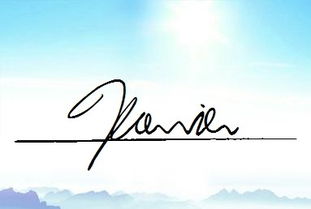Hey there, art enthusiast! Ever wondered how some people manage to make their signatures look like little masterpieces? That's right, we're diving into the fascinating world of English art signatures. Whether you're a budding artist or just curious about the craft, get ready to uncover the secrets behind those unique signatures that stand out from the crowd. So, let's embark on this creative journey and explore the art of signing off with style!
The Evolution of Signatures

Long before digital signatures and the simple scrawl of a pen, signatures were a symbol of identity and authenticity. In the world of English art, signatures have evolved into a form of self-expression. Imagine the signatures of famous artists like Leonardo da Vinci or Vincent van Gogh—each one a testament to their unique personalities and artistic prowess.
The Basics of English Art Signatures

To create an English art signature, you'll need a few essential tools: a pen, paper, and a bit of creativity. Here's a step-by-step guide to help you get started:
1. Choose Your Pen: The pen is the brush in your signature painting. Select a pen that feels comfortable in your hand and suits your desired style. Ballpoint pens, fine liners, and even markers can all be used to create stunning signatures.
2. Experiment with Styles: Don't be afraid to experiment with different fonts and styles. You can go for a classic script, a bold and chunky look, or even something more abstract. Remember, your signature is a reflection of your personality, so have fun with it!
3. Practice Makes Perfect: Like any art form, creating a unique signature takes practice. Try writing your name in various ways until you find a style that resonates with you. Don't worry if it takes a few tries; the process is all part of the journey.
4. Incorporate Elements: Once you've settled on a style, consider adding unique elements to make your signature stand out. This could be a simple dot, a stylized initial, or even a small emblem or symbol that holds personal significance.
Inspiration from the Greats

To get a taste of what's possible, let's take a look at some famous English art signatures:
- John Lennon: The late musician's signature is a classic example of a simple yet stylish script. It's bold and legible, making it easy to recognize.
- J.K. Rowling: The author of the Harry Potter series has a signature that's both elegant and whimsical. It features a flowing script with a touch of whimsy, reflecting the magical world she created.
- David Bowie: The iconic musician's signature is a perfect blend of simplicity and sophistication. It's a straightforward script that's easy to read, yet it carries a sense of mystery and intrigue.
The Power of Personalization
Your signature is a personal statement, so why not make it uniquely yours? Here are a few ideas to help you personalize your English art signature:
- Incorporate Your Hobbies: If you love painting, why not add a small brushstroke or paint splatter to your signature? If you're a musician, perhaps a musical note or staff could be the perfect touch.
- Use Your Initials: If you prefer a more minimalist approach, consider using your initials in a creative way. You could combine them into a single, stylized emblem or use them as the basis for a more intricate design.
- Reflect Your Values: Your signature can be a reflection of your values and beliefs. Whether it's a simple cross, a peace sign, or a symbol representing your heritage, incorporating these elements can add a deeper meaning to your signature.
The Final Touch
Once you've created your English art signature, it's time to put it to use. Whether you're signing a letter, a contract, or even a piece of art, your unique signature will add a touch of personal flair to any document.
Remember, the art of signing off with style is all about expressing yourself. So, go ahead and experiment, have fun, and let your creativity shine through in every stroke of your pen. Happy signing!

